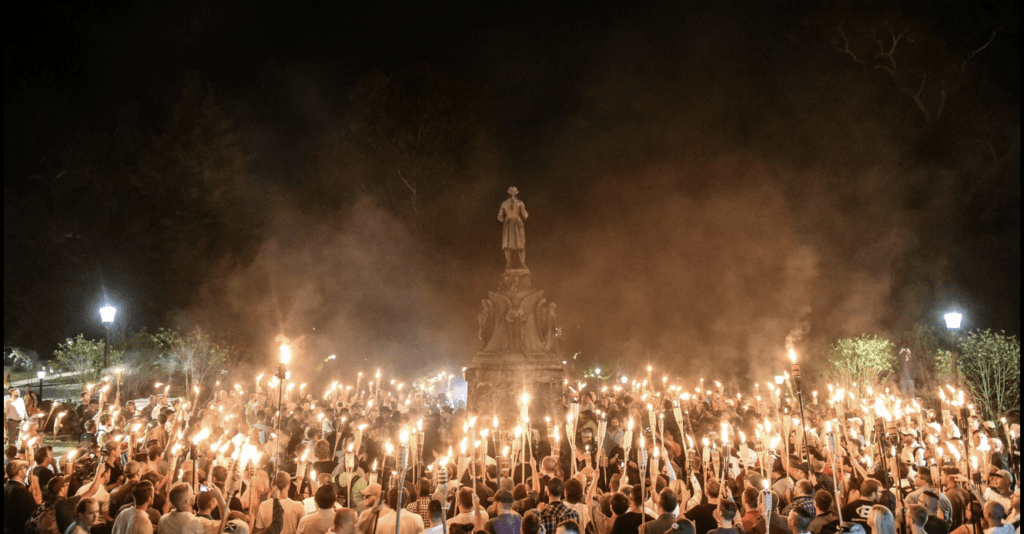Charlottesville’s Self-Evident Truths
 The statue of Thomas Jefferson at the University of Virginia, with white supremacist mob/Reuters
The statue of Thomas Jefferson at the University of Virginia, with white supremacist mob/Reuters
Lisa Van Dusen/For The Hill Times
August 18, 2017
Like so many places in the American South, Charlottesville is beautiful and haunted. Thomas Jefferson haunts the iconic University of Virginia campus he designed like an invisible chancellor, just as Sally Hemings and hundreds of other slaves haunt Monticello as self-evident truths in the course of human events.
In 2010, I took a guided tour of Jefferson’s hilltop plantation during which the words “slave,” “slaves,” and “slavery” were never mentioned. Since then, the $35-million Mountaintop Project, designed to accurately depict Jefferson’s persona as both a slave owner and the genius who authored the Declaration of Independence and its immortal assertion that all men are created equal, has transformed Monticello.
Thanks largely to billionaire philanthropist David Rubenstein, there are now, among other corrections, a Slavery at Monticello tour and a restored Mulberry Row slave quarters. History once referred to on the grounds sotto voce—as though the third president of the United States was the one inconvenienced by keeping fellow human beings in bondage—now has a Slavery at Monticello app.
Last Friday night, three miles from where Rubinstein helped excavate and represent the barbaric contribution of slavery to America’s evolution, white supremacists were marching through the streets of Charlottesville, wielding preposterous tiki torches and railing against Black and Jewish people. On Saturday, as the violence was peaking on a day that would see the murder of counter-protester Heather Heyer and the deaths of state police pilots Jay Cullen and Berke Bates in a helicopter crash while patrolling the chaos, United States President Donald Trump once again met his own apparently inviolable standard of being the least presidential president in history.
There’s been no national, public stacking of truth after truth about 400 years of slavery, lynchings, voter suppression, mass incarceration, institutional racism, profiling, and micro-aggressions.
The widespread revulsion triggered by his equivocal condemnation of the violence “on many sides” in Charlottesville and refusal to explicitly denounce Nazis and white supremacists has been such a constant of his tenure that it’s impossible to think of it as a strategic bug, not a feature. By sundown Saturday, a symphony of sanity had arisen, with outraged Republicans and outraged Democrats on Twitter, if not quite taking their country back, at least reminding the world that the hateful images emerging from Virginia were not representative of America.
In an age when political power is seen to reside with whomever dominates the daily narrative—regardless of whether it is authentic or manufactured, constructive or destructive—Trump practises a form of narrative domination based on the viral commodities of outrage, disgust, and despair. In the contest to drive the day, in which post-truth content and fake-news idiocy have become weaponized, homicidal Nazis trump all misogynistic tweets, executive falsehoods, and R-rated Scaramucci eruptions. On Monday, Trump caught up with humanity and made the statement he should have made Saturday.
In the matter of the larger narrative of American history, the fact that the relative value of Confederate statuary is still debated and a president can still contemplate the characterization of events Trump ventured on Saturday underscore an overriding reality.
Unlike South Africa and Canada, America hasn’t had a truth and reconciliation process. The National Museum of African-American History and Culture, opened on the National Mall last year, is an important declaration of historic truth, but the narrative it documents won’t be coming to a white supremacist meeting any time soon.
There’s been no national, public stacking of truth after truth about 400 years of slavery, lynchings, voter suppression, mass incarceration, institutional racism, profiling, and micro-aggressions. It would render white supremacy as a perversion of projected shame as ridiculous and as ridiculed as it should be, and expose it as a phenomenon whose very existence makes a lie of its label.
Lisa Van Dusen is associate editor of Policy Magazine. She was a senior writer at Maclean’s, Washington/international affairs columnist for the Ottawa Citizen and Sun Media, international writer for Peter Jennings at ABC News, and an editor at AP National in New York and UPI in Washington.
